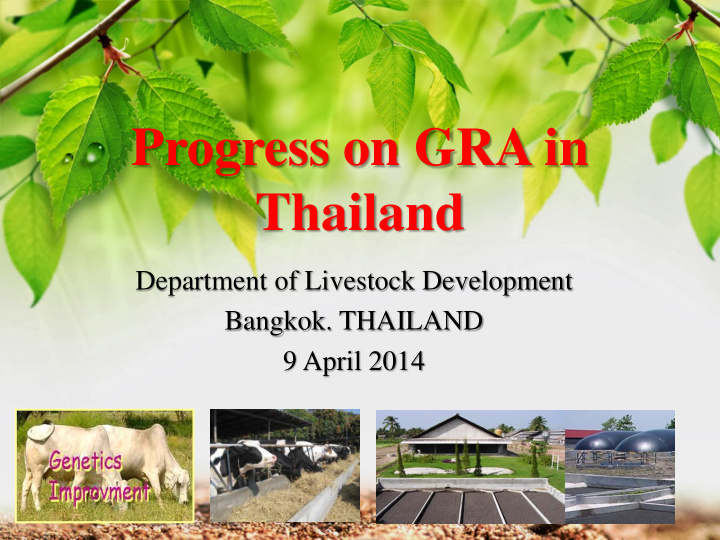



Progress on GRA in Thailand Department of Livestock Development Bangkok. THAILAND 9 April 2014
Contents Thailand policies for CC in agricuture sector Thailand involvement in GRA Thailand’s GRA activities in 2012-Now Improved Inventory and Mitigation of Greenhouse Gases in Livestock Production in South East Asia Benefit from GRA Ways forward
Thailand policies for CC in agricuture Policy Green production Start -1 st 2007-2011 -2 nd 2012-now Strategies -Adaptation -Mitgation
Thailand’s Involvement in GRA GRA was launched in December 2009 The Alliance member sign the Charter in June 2011 Thailand: joined GRA on 4th January, 2011 confirmed its membership on 10th April, 2012
Thailand’s GRA Activities in 2012-Now
1. Assign institutional contact points for each research groups Cropland Research Group Land Development Department Livestock Research Group Livestock Development Paddy Rice Research Group Rice Department Soil carbon & nitrogen cycling cross-cutting group Department of Agriculture Inventory and measurement cross-cutting group Office of Agricultural Economics
2. Inform researchers, academia, research institutes, research fund organizations, and greenhouse gas related organizations on Thailand’s engagement in GRA
3. Identify research priorities for each research group
Livestock Research Group Priority research Improve animal feed: animal feed varieties, processing equipment, production standard, grass land research Improve animal genetics to reduce GHG emission per unit of production Improve farm management and production system such as convert waste to energy Livestock GHG inventory and measurement Research on the diversity of rumen microorganism Capacity building of livestock GHG emission
4. International research collaboration and GRA research group meeting participation South East Asia project development (Funded by New Zealand) Objective: identify appropriate livestock classification systems and estimate emission across the regions Participating countries: Indonesia, Malaysia, Thailand, Vietnam Activities: Workshop/meeting in Bangkok (March 2012), Vietnam (September 2012), Indonesia (April 2013) Training: Enteric methane measurement by SF6 training course at AgResearch. Newzealand
Improved Inventory and Mitigation of Greenhouse Gases in Livestock Production in South East Asia -The Governments of Thailand and New Zealand jointly hosted a 2- day workshop on capacity building for the measurement and mitigation of greenhouse gases (GHGs) in South-East Asian livestock systems, on 14/15 March 2012 in Bangkok, Thailand. -Four countries from the region participated in the workshop: Thailand, Indonesia, Malaysia and Viet Nam. -The workshop was held under the auspices of the Livestock Research Group (LRG) of the Global Research Alliance on agricultural greenhouse gases (the Alliance), as part of a broader set of activities by the LRG to build regional capacity in developing countries.
Improved Inventor and Mitigation of Greenhouse Gases in Livestock Production in South East Asia(Cont) -The workshop was sponsored by the New Zealand government through its Ministry for Primary Industries as part of its support for the Alliance. -Subsequent to the workshop, the New Zealand Government agreed to fund a scoping study into current knowledge, scientific capacity and opportunities for further research to improve estimates of GHG emissions from livestock agriculture in the region and to identify mitigation opportunities.
Objectives •Describe the key livestock systems and the main associated livestock emissions in the SE Asia region. •Analyse the data set to identify common and, where relevant, country-specific priority areas for improvement of emissions estimates. •Identify specific and realistic steps by which livestock emissions inventories can be improved or modified to better reflect regional systems and practices for the identified priority areas and to reduce biases and uncertainties in regional emissions estimates. •Convene a workshop to discuss options, identify common priority actions, and agree on the final recommendations.
Regional priorities for improving emissions estimates and developing mitigation options -Improve data collection of the beef cattle population Livestock Total % of Total -Improve and refine region- and country-specific emission Dairy Cattle 58,758.56 3.20% Non-dairy Cattle 1,269,855.71 69.10% factors for enteric fermentation Buffalo 295,731.37 16.10% -Improve and standardise the collection of data on pig Sheep 60,268.17 3.30% manure management systems Goats 95,500.06 5.20% Camels 8.14 0.00% -Undertake targeted measurements of ammonia and NO x Horses 9,083.93 0.50% emission and N leaching from different manure Mules & Asses 19.45 0.00% Swine 47,432.01 2.60% management systems of pig production systems Total 1,836,657.40 100.00% -Develop a Tier 2 approach to livestock emissions
Benefit from GRA -Option for mitigation and production efficiency Livestock Total % of Total -Priority group of animal toimprove inventory Dairy Cattle 58,758.56 3.20% Non-dairy Cattle 1,269,855.71 69.10% system Buffalo 295,731.37 16.10% Sheep 60,268.17 3.30% Goats 95,500.06 5.20% -Invenventory system of GHG in country and Camels 8.14 0.00% Horses 9,083.93 0.50% region Mules & Asses 19.45 0.00% Swine 47,432.01 2.60% Total 1,836,657.40 100.00% -Capacty building
Ways Forward Extend cooperation and networks in agriculture greenhouse gas research Some priority researches/activities are already taken place -Training course for Livestock GHG inventory and measurement -Identify available data sets and additional data sets needed to prepare GHG inventory -Building capacity to estimate agriculture GHG emission - Ruminal micro-organism -GHG inventory -Nutrition and feeding system for mitigation option -CH4 measurement
Ways Forward -Next capacity buiding - Genetics and selection for low carbon livestock - N2O management - CH4 measuremnt Update priority research and incorporate it into the research budget
Thank you for your attention Department of Livestock Development Ministry of Agriculture and Cooperatives www.dld.go.th
Recommend
More recommend